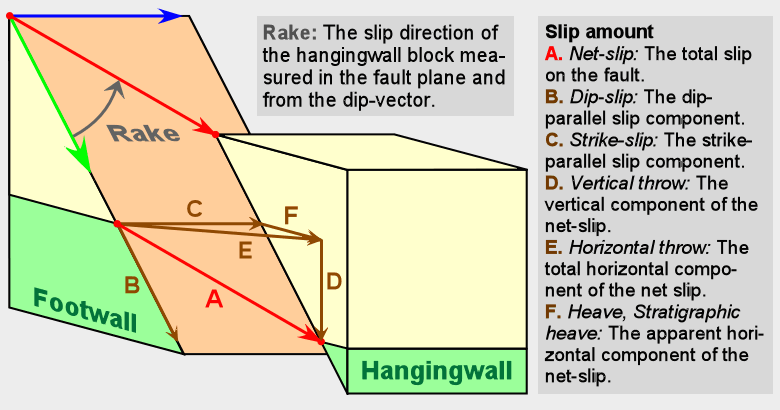| Fault slip and fault names | |
| This section reviews basic fault nomenclature. The diagram shows the basic fault-slip parameters. The blue arrow indicates the right-hand rule strike, the green arrow dip. The hangingwall is the fault block above the fault plane; the footwall is the fault block below the fault plane. |

Fault heave and throw can be deceptive because:
|
Figure 2: Vertical throw vs. stratigraphic throw

|
Basic fault names based on slip direction.
Fault names indicate the rake of the movement direction of the hangingwall. Rake
is the angle of the hangingwall slip-vector measured in the fault plane. There are many different rake
notations, but this website measures rake from the dip vector. Positive rakes are clockwise (as seen
looking down on the fault plane) and rake can range either from +180° to -180° or from 0°-360° depending on
your preference. I prefer the +180° to -180° scheme because rakes with absolute values <90° indicate normal
slip, >90° indicate reverse slip, positive rakes indicate right-lateral movement, and negative rakes indicate
left-lateral movement.
The next diagram shows how fault names relate to the hangingwall-slip rake. The diagram looks
perpendicularly down onto the fault plane. The green arrow is the dip-vector; the blue arrow is the
right-hand rule strike. In normal usage faults with slip-vectors lying within 10°-15° of the dip or
strike orientation (not
direction) are termed normal/reverse or right-/left-lateral
faults, respectively. Faults with slip-vectors outside of these ranges are given compound names.
The vertical or horizontal slip component of a vertical or horizontal fault is named arbitrarily.
Right-lateral vs. left-lateral.
Imagine that you are standing on one side of a steeply dipping fault as it moves. If objects on the
opposite block appear to be moving to your right, then the fault has a right-lateral component. If objects
on the opposite block appear to be moving to your left, then the fault has a left-lateral component.
The apparent movement is the same whether you are standing on the hangingwall or footwall.
|
Figure 3: The fault name describes the rake of the slip vector.

|
Special fault names.
Geologists use many different names for special types of faults. These names have complex and far-reaching implications that depend to some extent on the user. When in doubt, use a simple name. Some important types of specialized fault names:
Wrench vs. strike-slip fault. These terms are synonyms and indicate a fault with a slip-vector closely parallel to the fault strike. Some geologists reserve the term wrench for large, regional strike-slip faults, steeply-dipping regional strike-slip faults or as a synonym for tear fault. Thrust fault. This name once meant any reverse fault with a dip-angle of 30° or less. Now the term indicates faults with an originally low dip-angle that formed during regional compressional deformation. A single thrust fault may change its orientation as it crosscuts different lithologies. Folding can reorient thrusts so that they may have a variety of angles today. Detachment fault. A regional, low-angle, listric normal fault formed during crustal extension. Tear fault. Often used to indicate a steeply-dipping wrench fault that bounds or cuts the hangingwall of a thrust or normal fault, also used for mode III faults. |
|
Continue to next page in this sequence: Fracture identification flowchart |
Copyright © 2000 - 2017 • Alfred Lacazette • All Rights Reserved